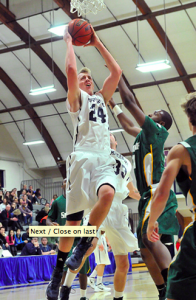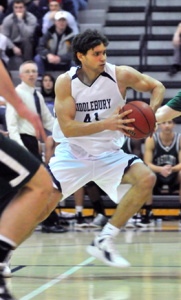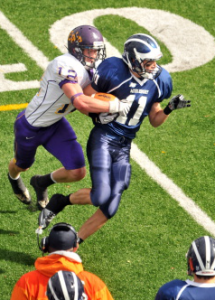Middlebury’s fall semester summary was posted a few days ago (here), and the 8-0 soon-to-be-top-ranked Panthers will kick off their post-break schedule this weekend at home against Rensselaer. The Panthers have shown they remain elite despite the loss of Ryan Sharry, and that they can beat lesser opponents, something that their fellow highly ranked New England foes (MIT, Amherst, Wesleyan) were not able to do consistently. The November and December games are closer to a preseason than a regular season for a team like Middlebury (now 31-0 in such games since 2009), and the defining games come in conference play and the tournament(s). Here are our five burning questions heading into the new year:
1. What does 8-0 mean?
The Panthers’ record means a better start, standings-wise, than every other team in the NESCAC and every team that was ranked above Middlebury in the pre-season Top 25, but anything less than 8-0 would have been cause for concern, so it doesn’t mean a lot (half of the team’s wins have been by single digits, and none have been against ranked opponents). In many of the early games, the Panthers looked shaky, but still in control. At times and for stretches they brought their A game, and looked elite at those times. In the second half of the most recent game vs. Skidmore, for example, we saw them pull away behind their trademark combination of hard defense (4 FGM) and efficient offense (46% FG, 50% 3FG). The question is whether that level of play is another gear everybody can kick into when the game is in jeopardy (Midd was losing 26-19 toward the end of the first half in that game), or a spark that comes and goes irregularly. If it is the former, 8-0 means things are going right; if it is the latter, 8-0 means things just haven’t lined up to go wrong yet, but that they will when the schedule tightens up.
2. Can Peter Lynch sustain his scoring numbers?
The senior captain, who averaged 9.8 points per game last season, has put up 17.3 per game on 69% shooting thus far this year, a stat-line even more impressive considering his 2-point no-show on opening night. He has taken over a bigger share of the points lost from Ryan Sharry’s departure than anybody expected, and if he continues to play at this level, with everyone else a year better, Middlebury might be better this year than last. Yet none of Middlebury’s early opponents had a true quality big man defender and Pete is an undersized (6’6″) post player who might struggle against longer, athletic defenders. Thus, it seems unreasonable not to expect his numbers to regress, because his production is limited by his size, and that will be the biggest noticeable variable in January/February. Last season, Pete actually improved his field goal percentage (up to 71%) in conference play, but he was the benefactor of Sharry-focused opponents down low. This year, he will be the go-to man in many half court sets, and we will find out just how much his game has improved.
3. When is Dylan Sinnickson returning?
The 6’5″ sophomore forward broke his arm in practice in November and was projected for a January return. We have seen him around campus and at practices, cast-less but dribbling/shooting with his left hand. Last season, the ultra-athletic Sinnickson averaged 5.7 points in 11.4 minutes per game, and we had been projecting him in a sixth man role for this season before the injury. Now, the front court is very crowded with the increased minutes of Jack Roberts, James Jensen, and Hunter Merryman alongside Lynch, and Sinnickson will have to find his game quickly to earn back his role. A quick return might be the only way he works his into the big game rotation given how many quality reserves Midd boasts and how soon they will be shortening the bench. There are nine games in January (plus one yet to be played at the end of December), but it is the last two (at Williams, vs. Keene State) when he will be needed most (because of the front courts those opponents boast).
4. How do you manage difference between starting lineup and best lineup?
Sophomore Jack Roberts is the starting center but he is probably the 7th or 8th best player on the team, behind both Merryman and Jensen. Currently, both of those reserves are averaging slightly more minutes per game (18.5 and 21.1, respectively) than Roberts (17.0), but Sinnickson’s return will complicate that situation. If Roberts drops down below 15 minutes per game, it will be interesting to see whether Jeff Brown keeps him in the starting rotation. Jack is the only conventional center of the group, and at 6’8″, is the best down low defender on the team, but the smaller guys are all more dynamic and complete players, so Coach Brown might try one out in the starting lineup. From this perspective, the best move is to keep Roberts starting because of the increased number of quality big opponents on the horizon and the need for his defense.
5. Is backcourt depth a concern?
Middlebury has the best starting guards in the conference in Joey Kizel, Jake Wolfin, and Nolan Thompson. However, after that, it is unclear whether the back court can hold up. Junior Nate Bulluck (10 mpg, 4.1 ppg, 37% FG) is talented and athletic but his tendency to put his head down and force shots is incongruent with this team’s playing style. Sophomore Dean Brierly (9 mpg, 2.4 ppg, 37% FG) plays smart but his scoring ability is not yet where it needs to be. Freshman Henry Pendergast (7 mpg, 2.2 ppg, 50% FG) is electric at times but too inconsistent (and too big of a liability at the free throw line) to trust with a regular spot in the rotation. Sophomore Albert Nascimento (3 games, 8 mpg, 6.3 ppg, 50% FG) has improved his game but is turnover-prone and shot-happy, a bad combination for a role player on a deep and efficient team. Right now, none of the four inspire confidence, but each is serviceable, and the group probably compares well to many NESCAC supporting casts (hard to say from an outsider’s perspective this early in the season). However, unless one player steps up (which wouldn’t be surprising), the lack of depth will leave the Panthers ill-equipped for foul trouble or injuries down the road.



